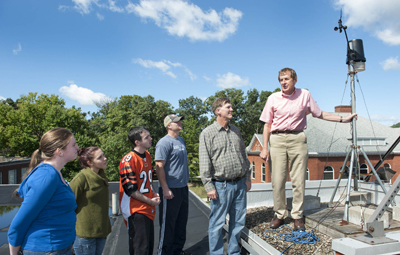Rain. It's the stuff of legend at IUP.
It seems like we get more than our fair share. In fact, when people say Seattle, Wash., is the rainiest city in the country, we say, Nah!! Indiana has Seattle beat.
Do we?

Professor Joe Bencloski (far right) and students check the weather station atop Leonard Hall.
According to Joe Bencloski, professor of geography and regional planning, Indiana does get a lot of rain—and, yes, we get about 10 more inches of rain than Seattle gets each year. The Pacific Northwest city averages about 38 inches of rain per year to Indiana's 48 inches.
“Our climates are very different, though,” Bencloski notes. “Both Indiana and Seattle experience the orographic effect, but Indiana is on the windward side of a topographic barrier, while Seattle is on the leeward side."
What does this mean?
“The perception is that Seattle is very rainy, because of the high frequency of cloudy, foggy days," Bencloski explains. "The orographic effect occurs when air is forced up the windward side of a mountain range, causing cooling, condensation and precipitation. As the air descends down the leeward side of a mountain, it compresses and warms. The warming causes relative humidity to decrease."
Indiana is also on a west-to-east storm track, so it's no surprise that we get a lot of drizzly, cloudy, rainy days as air rises up the windward side of the Appalachian Plateau,” Bencloski said.
“If you're a Christmas tree grower, it's great!” he said, alluding to that industry's longtime presence in the county.
The Department of Geography and Regional planning has hosted a Vantage Pro2 weather station on the rooftop of the department's classroom building, Leonard Hall, since 2009. The weather station is wired to a control unit in the department's computer lab.
Students in Bencloski's climatology course use data from the station as part of a required class project. During the fall semester, students record daily temperature, precipitation, relative humidity, atmospheric pressure, and wind readings.
They use this information to explain how Indiana's weather is linked to regional weather patterns and why the conditions exist.
The weather station is also helpful for people who want to check the temperature and wind chill on campus.
Mark Rice, of Information Technology Services, set up and maintains the station. He notes that the weather station uses a data logger called Weather Link IP, which is permanently connected to Davis Corporation instruments in California via the Internet. The logger collects and sends data at five-second intervals.
Updates from the station are available online at www.weatherlink.com.